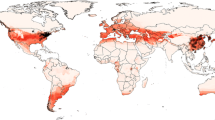Abstract
Gregarious swarms of red locust, Nomadacris septemfasciata (Serville) capable of causing loss to agriculture originate from specific breeding areas in eastern and central Africa often referred to as outbreak areas. Typically these areas are poorly drained grassland plains that flood during the wet season and then dry out, creating sites for egg laying and stimulating growth of specific types of vegetation necessary for nymphal survival. During 1996, a significant upsurge of red locust occurred throughout central and western Tanzania. Populations also appeared in the Bahi Plains west of Dodoma, an area where significant infestations of red locust had not been recorded since the major plague of 1930–1944. Aerial spraying controlled 13,700 ha of nymphal bands and swarms. The 1996 upsurge could have been caused by a number of contributing factors: a prolonged drought leading to changes in vegetation; possible changes to flood water levels through diversion for irrigation; and either an undetected movement of red locust into the area from outside or localised breeding over several seasons. As a result of this outbreak the Bahi is likely to remain as a possible source of red locust swarms in the future and should be monitored closely.
Résumé
Les essaims grégaires du criquet nomade, Nomadacris septemfasciata (Serville), capables de faire des dégâts au niveau de l’agriculture, trouvent leur origine dans des régions de reproduction spécifiques en Afrique orientale et centrale souvent nommées les aires grégarigènes. Ces aires sont principalement des plaines herbeuses mal drainées et susceptibles d’inondations de niveaux variables pendant la saison des pluies. Ces inondations créent des sites d’oviposition et stimulent la pousse des types de végétation spécifiques nécessaires à la survie des nymphes. En 1996, le centre et l’ouest de la Tanzanie ont connu une augmentation importante dans le nombre du criquet nomade. Des populations ont été signalées sur les plaines de Bahi, à l’ouest de Dodoma, cette région n’ayant jamais connu d’infestations importantes de cette espèce jusqu’alors. Cependant, un programme de traitement aerien a enrayé’la progression de 13.700 ha de bandes de nymphes et d’essaims. Nous pouvons également discerner plusieurs facteurs qui pourraient être à l’origine de cette augmentation: tout d’abord une période de sécheresse prolongée, ensuite d’éventuels changements dans les niveaux des crues, ceci dû à la dérivation des cours d’eau pour l’irrigation; soit un déplacement non-détecté du criquet nomade d’une source extérieure vers cette région, soit de la reproduction localisée pendant plusieurs saisons. Par conséquent, le Bahi est une source possible d’essaims du criquet nomade dans l’avenir et devrait donc rester sous haute surveillance.
Similar content being viewed by others
References
COPR (1982) The Locust and Grasshopper Agricultural Manual. COPR, London, pp. 345–354.
Gunn D. L. (1955) Mweru wa Ntipa and the red locust. N. Rhod. J. 2, 1–15.
Gunn D. L. (1956) A history of Lake Rukwa and the red locust. Tanganyika Notes Rec. No. 42, 1–18.
Morant V. (1947) Migrations and breeding of the red locust (Nomadacris septemfasciata (Serville)) in Africa, 1927–1945. Anti-Locust Mem. No. 2, 59 pp.
Robertson I. A. D. (1958) Tree-planting trials for the control of the red locust, (Nomadacris septemfasciata) in the Rukwa Valley, Tanganyika. East Afr. Agrie. J. XXIII, 172–178.
Symmons P. M. (1978) The prevention of plagues of the red locust, Nomadacris septemfasciata (Serv.). Acrida 7, 55–78.
Symmons P. M. and Carnegie A. J. M. (1959) Some factors affecting breeding and oviposition of the red locust, Nomadacris septemfasciata (Serv). Bull. ent. Res. 50, 333–353.
Vesey-Fitzgerald D. F. (1955) The vegetation of the outbreak areas of the red locust (Nomadacris septemfasciata (Serville)) in Tanganyika and Northern Rhodesia. Anti-Locust Bull. No. 20, 31 pp.
Author information
Authors and Affiliations
Corresponding author
Rights and permissions
About this article
Cite this article
Spurgin, R.A., Chomba, R.S.K. The Bahi Plains—An Additional Red Locust Outbreak Area in Central Tanzania?. Int J Trop Insect Sci 19, 277–282 (1999). https://doi.org/10.1017/S1742758400018890
Accepted:
Published:
Issue Date:
DOI: https://doi.org/10.1017/S1742758400018890




